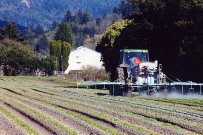Siskiyou Land Conservancy Endorses Short-Sea Shipping for Humboldt Bay and the North Coast
A major local initiative — a short-sea shipping “Manhattan Project” — is needed now to ensure that Humboldt and the North Coast take advantage of this new “wave” of commerce and protect our environment.
It may seem odd for a land trust to “endorse” product transport. However, it’s well known that a strong North Coast economy anchored by small, specialized manufacturing and service industries can do almost as much to protect vital habitat as outright land preservation.
The reason is that a weak economy in a rural area can make land liquidation, tract home development and strip malls an attractive economic alternative. In a region where most large land holdings are in timber, and in an era when the timber market is deeply under water, the prospect of forest holdings being broken up and sold off is acute.
Some business leaders in our area are looking at real estate and associated services — realtors, surveyors, loan agents, contractors, etc. — as the next big thing. Before filing for bankruptcy Pacific Lumber exemplified the point by announcing, in 2008, that the company would sell off some 28,000 acres, in individual, ignominiously named “kingdoms,” for about $4 million each. The “kingdoms” would surround the half-dozen ancient redwood groves — including the largest, 3,000-acre Headwaters Grove — that were protected a decade before.
It doesn’t take a hydrologist to figure out what all the new roads and tree removal and household pesticide use would do to the already beleaguered salmonid streams that flow out of these lands. Here the fisheries are holding on by a thread; the Kingdoms would have snipped them like so much filament. Likewise, sensitive ancient forest-dependent species would suffer massive disturbance from human intrusion.
Siskiyou Land Conservancy serves five counties in northwestern California: Del Norte, Trinity, Siskiyou, Mendocino and Humboldt. We primarily protect important habitats through purchase and conservation easement. But there are many mechanisms to consider for an organization with such a mission. The strength or weakness of particular economic sectors can protect or break ecosystems.
What industries can we rely on to sustain our economy without wrecking the land?
Municipalities are the biggest employers in our area, and they’re cutting staffs with a vengeance. Likewise Humboldt State University, the second-largest employer, is undergoing massive cuts and they haven’t hit bottom yet.
There is no question that real estate development, especially of lands currently zoned “timber production” and “agricultural,” remains a real threat to the ecology of the North Coast. That’s why in Humboldt County many of the “property rights” groups are really fronts for large landowners who want unimpeded county approval for major subdivisions. It’s already happening. Green Diamond, Sierra Pacific Industries and others are subdividing and selling off properties. Plans to develop tens of thousands of acres of timberlands in Humboldt, Mendocino and Del Norte Counties are in the works, or have already happened. In other regions companies such as Weyerhaeuser, Plum Creek and Stimson are liquidating vast tracts of timberland for housing developments. In fact, most large timber companies in the U.S. today, including Green Diamond and Sierra Pacific, have a real estate branch.

From Healthy Humboldt: Green Diamond owns most of the Ryan Creek watershed, including the area known as the McKay Tract, above. Green Diamond’s 2008 McKay Tract Master Plan encompasses nearly 1,000 acres, with 442 acres slated for residential development along the lower reaches of Ryan Creek. A tributary of Freshwater Slough, Ryan Creek is regarded as the best remaining coho overwintering habitat in the Humboldt Bay area. Green Diamond’s road system has been the subject of much restoration work to reduce sediment, all for the improvement of fish habitat. Development of Ryan Creek could harm or destroy this critical Coho habitat.
What does short-sea shipping have to do with preventing developers from filling local hillsides with trophy homes? Plenty. Short-sea shipping is a growing industry that in Humboldt Bay has the potential to create hundreds of good paying jobs with negligible impact on the environment. Short-sea shipping requires almost no dredging, as most goods are shipped on barges. Short-sea shipping is up to 5 times more efficient than trucking goods, and from, say, Humboldt to the Bay Area it’s almost as fast. Shipping costs would plummet. Short-sea shipping would increase the ability of small, coastal communities to create and sustain niche manufacturing businesses, as shipping goods (and receiving raw materials) would become much easier and more affordable if it occurred on short-sea barges.
In fact, it’s already happening in Humboldt Bay. Stephen Pepper, of Humboldt Maritime Logistics, is already out the gate, at least conceptually. Here’s from his web site:
“People often talk about short sea shipping like it’s an ideological concept that’s going to require great coastal bureaucratic cooperation and infrastructure improvements,” says Pepper. “But we think of short sea shipping as the connection of existing freight lanes into a continuous loop, allowing shippers to pool freight into increased economies of scale and gain greater coastal market access. A well organized and specifically designed coastal freight program will work to the benefit of all participating shippers.
“We see this as an appropriately scaled service to our community, one that can be implemented easily here in Humboldt Bay as the barge service comes to fruition. We see this as a way to stimulate our local economy, create jobs, and help insulate our shippers from rising transportation costs and impending air quality restrictions.”

A barge and two ships in Humboldt Bay off Eureka, 1947. Shuster Collection, Humboldt State University.
But Pepper can’t do it by himself. A successful short-sea shipping operation in Humboldt Bay will require a public-private collaboration involving governments, businesses, planners, and the think-tanks at Humboldt State University (with special input from Schatz Energy) and College of the Redwoods. Public-private collaboration on short-sea shipping is already happening in the Bay Area.
And what better time to forge the partnership, as just two weeks ago the federal Department of Transportation announced a new program to “expand use of America’s marine highways.” According to a DOT press release, the new program “will help identify rivers and coastal routes that could carry cargo efficiently, bypassing congested roads around busy ports and reducing greenhouse gases.”
Another huge plus is that the promise of short-sea shipping should be enough to forestall ultimately destructive plan by CalTrans to “realign” Highway 101 through Richardson Grove in order to allow bigger trucks into (and, perhaps more importantly, through) Humboldt County.
The Richardson Grove project has triggered one of the most important and divisive debates about local roads since the California Division of Highways began blazing freeways through protected ancient redwood forests beginning in the 1960s.
In May 2010, CalTrans is expected to release a final Environmental Impact Report (EIR) for the Richardson Grove project. The failings of the draft EIR — including inadequate consideration of impacts such as potential damage to old-growth redwood roots, increased truck traffic, and growth inducements — have been well documented by others. Needed now is a viable alternative that will support the ability of small business to remain and thrive on the North Coast. That alternative is short-sea shipping.
But wait, there’s more. Humboldt Bay is not only perfectly suited to utilize short-sea shipping. This bay — with all its idle docks and the mouth dredged as deep as Oakland’s — and a bankrupt Eureka in particular would make an excellent homeport for repairing, storing and even building ships and barges. Think this is infeasible? Think again. If the short-sea shipping industry indeed grows, as the federal government is predicting and even financing, then U.S. and West Coast based facilities for these services will grow in kind. The reason for this is that federal law requires it.
Here’s from Wikipedia: “The Merchant Marine Act of 1920 (P.L. 66-261) is a United States federal statute that regulates maritime commerce in U.S. waters and between U.S. ports. Section 27, also known as the Jones Act, deals with cabotage (i.e., coastal shipping) and requires that all goods transported by water between U.S. ports be carried in U.S. flag ships. These ships must be constructed in the United States, owned by U.S. citizens, and crewed wholly by U.S. citizens. The purpose of the law is to support the U.S. merchant marine industry. In addition, amendments to the Jones Act, known as the Cargo Preference Act (P.L. 83-644), provide permanent legislation for the transportation of waterborne cargoes in U.S.-flag vessels.”
In other words: The boats have to be built in the United States. The crew has to be American, the repairs have to be done in a U.S. port. The boats must be berthed in U.S. ports. Gee, can anyone think of an underutilized seaport in the Western United States that could serve as a home for these things?
A couple of years back a slim majority of the Humboldt Bay Harbor District floated a ludicrous plan to utilize funding from Goldman Sachs (now under federal indictment) to turn Humboldt Bay into a major seaport berthing massive container ships full of Chinese junk and gaudy cruise ships laden with blinkered tourists. Once again a few greedy locals wanted to exploit the resources and beauty of the area to the maximum degree, at the expense of the environment and everyone else. But we’ve learned. The major port idea is dead in the water, Goldman Sachs has returned to Wall Street to fleece some other desperate community, and Humboldt County is again thinking positively of its future.
Short-sea shipping is a marvelous alternative. It’s not a panacea, by any means. But if done right, people will look back and call the effort “visionary.”


